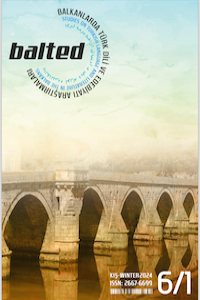Abstract
Balkanlardan Kazak ve Kırgız bozkırlarına kadar uzanan Türkistan coğrafyasını ve bu coğrafyanın bellek mekânlarını şiirinde işleyen Altay, Mağcan Cumabayev’in Türkistan şiirindeki Aral ve Balkaş göllerini şiirine almıştır. Siri Derya ve Amu Derya’nın yer aldığı Maveraünnehir, Altay’ın şiirinde sihirli ve ürperticidir. Cumabayev ise bu iki mübarek suyun kenarında, atalarının kutsal mezarlarını bulmanın heyecanıyla yaşamaktadır. Her iki şair de Türk’ün kutsal dağlarından bahseder. Altay, Hisar Dağları, Pamir ve Tanrı Dağları’nı şiirine almıştır. Cumabayev’de dağlar daha da ağırlık kazanmıştır. Pamir Dağları’ndan, Alay, Tyen-Şan, Tanrı ve kutsal Kızılkurt Dağı’ndan bahsetmiş, Kutsal Kızılkurt Dağı olmasaydı, Nuh’un Gemisi’nin kurtulamayacağını belirterek, insanlığın kaderini, Türkistan’ın bu kutsal dağına bağlamıştır. Her iki şair de Türkistan coğrafyasındaki çöl ve bozkırlara şiirlerinde yer vermiştir. Altay, Kızıl Kum ve Kara Kum çöllüklerini, Cumabayev ise, Turan’ın uçsuz bucaksız çöllerini dile getirmiştir. Cumabayev’de bu uçsuz bucaksız çöller, rüzgâr esmeyen, ıssız, sapsarı ve kumsar çöllerdir ve mezarlığı andırırlar. Altay ise bu çölleri, göklerin indirilmek istendiği mekânlar olarak telakki etmiştir. Balkaş’ı bağrına basan Tarbagatay bozkırlarından bahseden Cumabayev’in yanında, Kırgız bozkırlarından bahisle şiirini sonlandıran bir şair bulunmaktadır. Çalışmada, iki Türkistan şiirindeki bellek mekânlarından yola çıkılarak, şairlerin millî duyuşları ve Balkanlardan Kazak ve Kırgız bozkırlarına kadar uzanan Türkistan coğrafyasının bellek mekânları, her iki şiirde kullanılan bağlamsal anlamlar değerlendirilecektir.
References
- Anderson, B. (2009). Hayali Cemaatler Milliyetçiliğin Kökenleri ve Yayılması. (İskender Savaşır, Çev.). İstanbul: Metis.
- Bakhtin, M. (2001). Karnavaldan Romana Edebiyat Teorisinden Dil Felsefesine Seçme Yazılar (Sibel Irzık, Çev.). İstanbul: Ayrıntı.
- Engüllü, S. F. H., Canım R. (2013). Kıbrıs ve Balkanlarda Türk Şiiri. Eskişehir: Türk Dünyası Kültür Başkenti Ajansı.
- Halbwachs, M. (2018). Kolektif Bellek. (Zuhal Karagöz, Çev.). İstanbul: Pinhan Yayıncılık.
- Karakuş, E. (2023). K. Makedonya ve Kosova Türk Şiirinde Türkistan ve Türk Dünyası. Türkoloji, (114), 57-89.
- Kınacı Baran, C. (2021). Kazakistan’da Sovyet Devrinden Bağımsızlık Dönemine Değişen Kazak Edebiyatı. Türkoloji, (106), 30-43.
- Kişmir, A. (2021). Türkiye’de Hindistan Çalışmaları-I, Hafıza Mekânı Olarak Tac Mahal. (Dündar, M; Kayalı, Y. [Ed.ler]). Ankara Üniversitesi.
- Mutlu, H. K. (2017). Mağjan Jumabayev ve Türkistan Şiiri. Uluslararası Türk Lehçe Araştırmaları Dergisi, 1(2). 56-66.
- Nora, P. (2006). Hafıza Mekânları (Mehmet Emin Özcan, Çev.). Ankara: Dost Kitabevi.
- Onaran, S., Kişmir, G. (2018). Berlin’de Bir Mezar ve Gaipten Gelen Sesler: Uwe Timm’in Yarı Gölge Romanında Bellek Mekânının Edebi Kurgulanışı. Sivas: Cumhuriyet Üniversitesi Matbaası.
- Şahin, V. (2018). Şiirlerde Bellek ve Mekân Olarak Palu. Uluslararası Palu Sempozyumu, Elâzığ: Fırat Üniversitesi Harput Uygulama ve Araştırma Merkezi Yayınları.
- Tamir, F. (1993). Mağjan Cumabayef Öleñderi - Mağjan Cumabayulı’nın Şiirleri. Ankara: Türk Kültürünü Araştırma Enstitüsü Yayınları.
- www.gercekhayat.com.tr. [Erişim tarihi: 05.11.2023] (https://www.gercekhayat.com.tr/asya/orta-asya-diye-bir-yer-yok-orasi-ulu-turkistan)
Abstract
Seeing the geography of Turkestan from the Balkans to the Kazakh and Kyrgyz steppes and memory places of this geography in his poem, Altay included the Aral and Balkaş lakes, the poem of Magcan Cumabayev in Turkestan, into his poem. Transoxiana, with Siri Derya and Amu Derya, is magical and creepy in Altay's poetry. Cumabayev, on the other hand, lives with the excitement of finding the holy tombs of his ancestors in these two blessed waters. Both poets talk about the sacred mountains of the Turk. Altay included Hisar, Pamir and Tanrı Mountains in his poetry. In Cumabayev, the mountains gained even more weight. He talked about the Pamir, Alay, Tian-Shan and the holy Kızılkurt Mountain. Both poets included the outside and steppes of the Turkestan geography in their poems. Altay expressed the security of Kızıl Kum and Black Sand, and Cumabayev expressed the vast deserts of Turan. In Cumabayev, these vast circles, windless, desolate, yellow and sandy circles resemble a cemetery. Altay, considered these standards as places where the heavens are wanted to be lowered. There is a poet who ends his poem by observing the Kyrgyz steppes next to Cumabayev, who talks about the Tarbagatay steppes, which embraced Balkhash. In the study, starting from the memory places in the two Turkestan poems, the national feelings of the poets and the memory spaces of the Turkestan geography extending from the Balkans to the Kazakh and Kyrgyz steppes, the contextual meanings used in both poems will be tried to be evaluated.
References
- Anderson, B. (2009). Hayali Cemaatler Milliyetçiliğin Kökenleri ve Yayılması. (İskender Savaşır, Çev.). İstanbul: Metis.
- Bakhtin, M. (2001). Karnavaldan Romana Edebiyat Teorisinden Dil Felsefesine Seçme Yazılar (Sibel Irzık, Çev.). İstanbul: Ayrıntı.
- Engüllü, S. F. H., Canım R. (2013). Kıbrıs ve Balkanlarda Türk Şiiri. Eskişehir: Türk Dünyası Kültür Başkenti Ajansı.
- Halbwachs, M. (2018). Kolektif Bellek. (Zuhal Karagöz, Çev.). İstanbul: Pinhan Yayıncılık.
- Karakuş, E. (2023). K. Makedonya ve Kosova Türk Şiirinde Türkistan ve Türk Dünyası. Türkoloji, (114), 57-89.
- Kınacı Baran, C. (2021). Kazakistan’da Sovyet Devrinden Bağımsızlık Dönemine Değişen Kazak Edebiyatı. Türkoloji, (106), 30-43.
- Kişmir, A. (2021). Türkiye’de Hindistan Çalışmaları-I, Hafıza Mekânı Olarak Tac Mahal. (Dündar, M; Kayalı, Y. [Ed.ler]). Ankara Üniversitesi.
- Mutlu, H. K. (2017). Mağjan Jumabayev ve Türkistan Şiiri. Uluslararası Türk Lehçe Araştırmaları Dergisi, 1(2). 56-66.
- Nora, P. (2006). Hafıza Mekânları (Mehmet Emin Özcan, Çev.). Ankara: Dost Kitabevi.
- Onaran, S., Kişmir, G. (2018). Berlin’de Bir Mezar ve Gaipten Gelen Sesler: Uwe Timm’in Yarı Gölge Romanında Bellek Mekânının Edebi Kurgulanışı. Sivas: Cumhuriyet Üniversitesi Matbaası.
- Şahin, V. (2018). Şiirlerde Bellek ve Mekân Olarak Palu. Uluslararası Palu Sempozyumu, Elâzığ: Fırat Üniversitesi Harput Uygulama ve Araştırma Merkezi Yayınları.
- Tamir, F. (1993). Mağjan Cumabayef Öleñderi - Mağjan Cumabayulı’nın Şiirleri. Ankara: Türk Kültürünü Araştırma Enstitüsü Yayınları.
- www.gercekhayat.com.tr. [Erişim tarihi: 05.11.2023] (https://www.gercekhayat.com.tr/asya/orta-asya-diye-bir-yer-yok-orasi-ulu-turkistan)
Details
| Primary Language | Turkish |
|---|---|
| Subjects | Turkish Language and Literature (Other) |
| Journal Section | Articles |
| Authors | |
| Publication Date | January 31, 2024 |
| Published in Issue | Year 2024 Volume: 6 Issue: 1 |

BALTED is licensed under a Creative Commons Attribution-NonCommercial 4.0 International License.


